
Wildlife of the San Francisco Bay Area
Scorpions of San Franscisco Bay Area
It comes as a surprise to many people that Scorpions are found in the Bay area. They are almost always not a danger and are very rarely seen unless you go looking for them. They are nocturnal and hunt after dark. Most stings are not serious and have only a local effect unless the sting victim is allergic to the scorpion's venom.
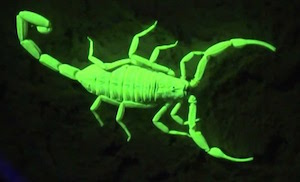
You need to search for them at night (when they are most active) using a UV light (black-light). Scorpions fluoresce under UV light, glowing yellow or green.
Bay Area Scorpions
- California Forest Scorpion - Uroctonus mordax
- California Common Scorpion - Paruroctonus silvestrii
- Monterey Dunes Scorpion - Paruroctonus maritimus
- Paruroctonus variabilis (very rare in the Bay area)
- Sawfinger Scorpion - Serradigitus gertschi
- Uroctonites montereus
- California Swollenstinger Scorpion - Anuroctonus pococki
Scorpion Notes
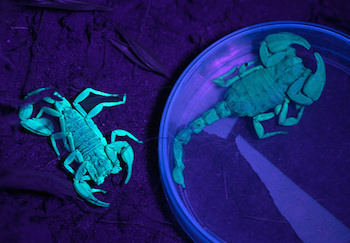
California Common Scorpion (left) and California Forest Scorpion (right)
Photo credit Natalie McNear
- Both species are common in California and can be found in the same habitat, complicating identification. The color of both species is variable but note the difference in proportions between the two species. P. silvestri (left) is generally more slender, with a relatively fat tail and gracile pedipalps (pinchers/claws). U. mordax (right) tends to have a more squat body with a skinny tail and massive claws. Neither species is normally considered dangerous to humans. (Notes thanks to Natalie McNear)
- The California Forest Scorpion is the commonest species in the Bay area and seems to be widespread.
- The Monterey Dunes Scorpion has been proposed as a threatened or endangered species due to its extremely limited distribution. It is found only in the coastal dunes of northern Monterey County. (photo and note thanks to R. J. Adams)
- The Sawfinger Scorpion has long, slender fingers that terminate in an enlarged clawlike denticle, and is quite small, only to about 20-25mm. (Note thanks to Kari McWest). It seems to be regularly found in the eastern part of the East Bay. There are also records from Mount Hamilton.
- Uroctonites montereus, occurs in the California coast ranges from San Mateo County south. It has also been recorded from Alameda County.
- The California Swollenstinger Scorpion has been found at Pinnacles National Park.
Scorpion Articles/Links
Home
Wildlife
|--Species
|--Mammals
|--Birds
|--Reptiles
|--Amphibians
|--Fish
|--Sharks
|--Insects
|--Butterflies
|--Dragonflies
|--Spiders
|--Crabs
Places
|--Locations
|--Bay Area
|--Local Sites
Activities
|--Activities
|--Butterfly Counts
|--Commercial
Resources
|--Books
|--Photos
|--Organizations
|--Rescue/Rehab
|--Local Sites
|--Links
|--News
Site Info
|--Blog
|--Search
|--Contact Us
|--About Us
|--Internships
Related Links
|--Spiders
|--Other species
Wildlife
|--Species
|--Mammals
|--Birds
|--Reptiles
|--Amphibians
|--Fish
|--Sharks
|--Insects
|--Butterflies
|--Dragonflies
|--Spiders
|--Crabs
Places
|--Locations
|--Bay Area
|--Local Sites
Activities
|--Activities
|--Butterfly Counts
|--Commercial
Resources
|--Books
|--Photos
|--Organizations
|--Rescue/Rehab
|--Local Sites
|--Links
|--News
Site Info
|--Blog
|--Search
|--Contact Us
|--About Us
|--Internships
Related Links
|--Spiders
|--Other species
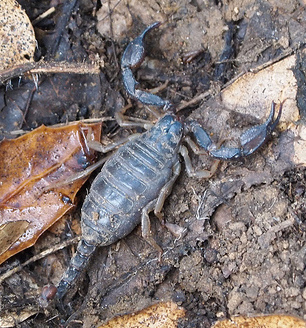 California Forest Scorpion - Uroctonus mordax (Almaden-Quicksilver County Park) Photo credit J. Maughn |
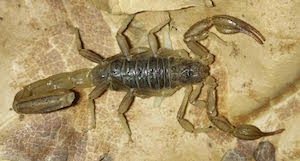 California Common Scorpion - Paruroctonus silvestrii (Pleasanton) Photo credit Akira |
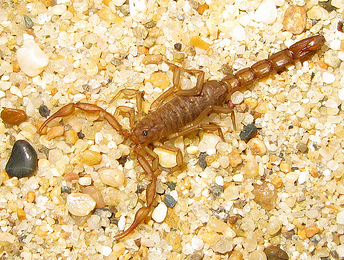 Sawfinger Scorpion - Serradigitus gertschi (Livermore) Photo credit Sarah Crews |
© 2007-2019 InfoPlace, Inc. All rights reserved